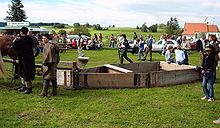Snowplow

A snowplow (also spelled snow plow, see miscellaneous spelling differences) is a vehicle, or a device intended for mounting on a vehicle, for removing snow and sometimes ice from outdoor surfaces, typically those serving transportation purposes. In many cases, pickup trucks and tractors are outfitted with plows to fulfill this purpose. In areas that regularly receive large amounts of snow every year, and also in specific environments such as airfield, specifically snowplowing winter service vehicles are used. Some regions that do not frequently see snow may use graders and other equipment to fulfill this task, but graders are nonetheless the best equipment to remove compacted snow and ice off the streets. Snowplows can also be mounted on rail cars to clear railway tracks.
A snowplow works by using a blade to push snow to the side or straight ahead, clearing it from a surface. Modern plows may include a great deal of technology to make the job—and staying on the road—easier, such as Global Positioning System receivers, head-up displays and infrared cameras.
When snowfalls accumulate above a certain height, snowplow operators may be seen clearing primarily designated "snow routes", often for the exclusive use of emergency vehicles such as fire trucks.
History

The first snowplows were horsedrawn wedge-plows made of wood. With the advent of the automobile, a number of inventors set about to improve existing snowplows. In the US, patents were issued for snowplow improvements at least as early as 1920.
In 1923, the brothers Hans and Even Øveraasen of Norway constructed an early snowplow for use on cars (David I Munson invented the first snow plow in 1911 and he invented a mechanism to attach it to the front of his truck, original patents are in a library basement in Boston, Mass.). This proved to be the start of a tradition in snow-clearing equipment for roads, railways[1][2] and airports, as well as the foundation of the company Øveraasen Snow Removal Systems. Carl Frink of Clayton, New York, USA was also an early manufacturer of automobile-mounted snowplows. His company, Frink Snowplows, now Frink-America, was founded by some accounts as early as 1920.[3]
Tow Plow

The TowPlow is an advanced snow plow first implemented by the Missouri Department of Transportation as a better tool to clear snow from highways.[4]
The tow plow consists of a truck with a regular plow blade in front and a secondary 26 foot blade attached to the side of a trailer. When the vehicle is in motion, the rear trailer's wheels are turned towards the blade causing the trailer to swing to the right of the truck and across the next lane. The trailer's blade is then dropped allowing one truck to clear two parallel lanes, a job which would take two trucks with one plow each. The TowPlow truck is equipped with cameras to provide the operator a view of the trailer and a laser to mark where the blade will be. The tow plow only results in a 10-15% increase in fuel usage and one less operator is necessary. The design was inspired by farm equipment which works similarly.
Besides Missouri, the tow plow is gaining popularity in other areas as equipment is updated and evaluated. It has been approved for use in Ontario where Highway 407 was the first user. The Tow Plow is currently produced and distributed through Viking-Cives of Mount Forest,Ont.
The TowPlow was first used in Kansas City, Missouri in January, 2005. Missouri was the first state, with Minnesota being the second state to adopt. Eastern Canada contractors also use them, with over a couple dozen now in the field to operate in Winter 2008. The TowPlow allows one truck and one operator to more than double the performance of each snow plow truck. Each TowPlow truck combination clears two lanes of pavement, over 24' wide with one truck.
Railway Snowplows

In many countries, railway locomotives have small snowplows permanently attached to their bogies, which also serve as pilots. With others, the snowplow forms part of the obstacle deflector below the bufferbeam. Bolt-on versions also exist, and these attach to the bufferbeam or front coupler. However, larger snowplows exist, which tend to be conversions rather than purpose-built vehicles. Steam locomotive tenders, large diesel locomotive bogies and various freight vehicles have been used, with the snowplow body mounted on the original frames. They are one-ended, with conventional coupling equipment on the inner end.
Conventional operation may see one or two locomotives running together with a snowplow at either end. This enables a snow clearance train to reverse direction quickly if it gets stuck. Alternatively, a single locomotive with bogie plows can act as a self-propelled snowplow by running light engine.
See also
- Snow blower
- Rotary snowplow
- Winter service vehicle
- "Mr. Plow", an episode of The Simpsons about snow removal.
Gallery
-
A small sidewalk clearing plow in Ottawa, Ontario, Canada
-
Sidewalk snowplow in Hallowell, Maine, USA
-
A streetplow in Germany
-
An other German snowplow near Tübingen
-
A street plow in Quebec City
-
A small wedge plow mounted on a passenger train in Lower Austria
-
A grader plowing snow
-
Garbage trucks fitted with snowplows
-
Backhoe fitted with special snowplowing attachment
-
Snow plow attached to an agricultural tractor
-
CPR prairie rail snowplow
-
CNR prairie rail snowplow
-
LIRR snowplow, made from an old caboose, behind an even older one
References
- ^ "Canadian Railway Hall of Fame -". Rotary snow plow (2002). 2006. Retrieved 2008-10-03.
{{cite web}}: Cite has empty unknown parameter:|coauthors=(help) - ^ Dysgraphyk (01 of February 2008). "scot-rail.co.uk » Snow ploughs". Retrieved 2008-10-03.
{{cite web}}: Check date values in:|date=(help); Unknown parameter|coauthors=ignored (|author=suggested) (help) - ^ "After 80 Years, Clayton Plow Plant Shuts Down". CNY Business Journal. 2000.
- ^ [1]















